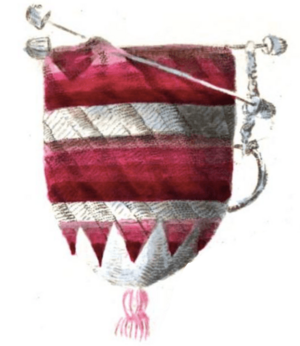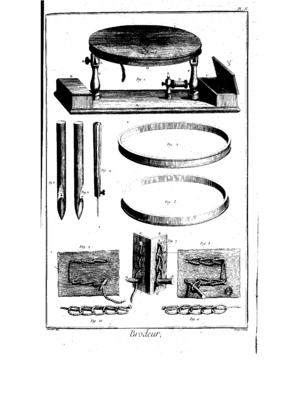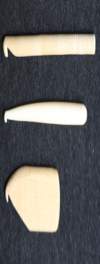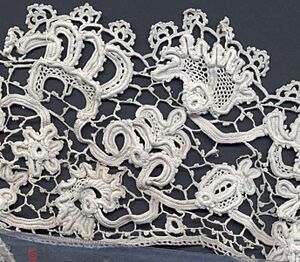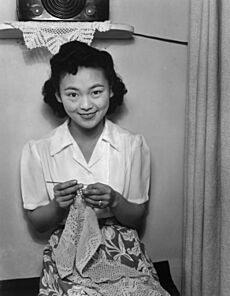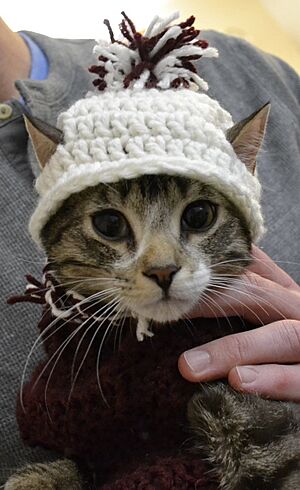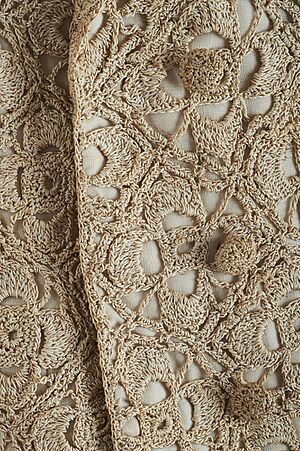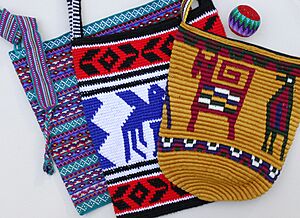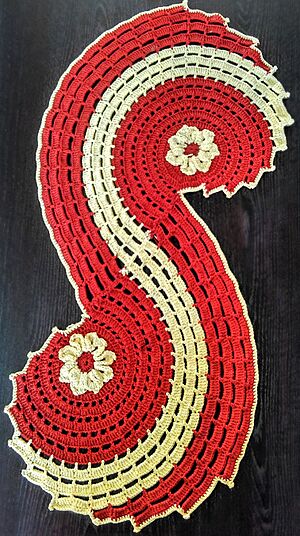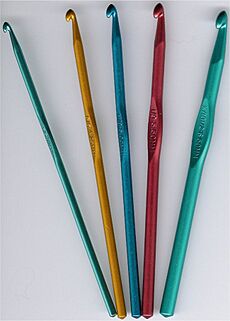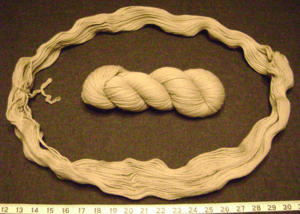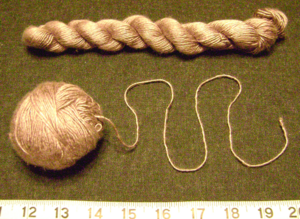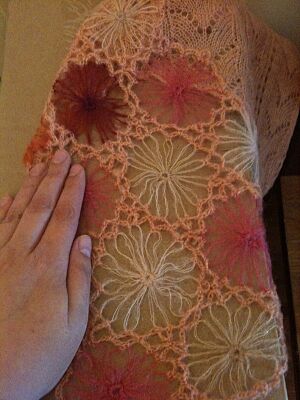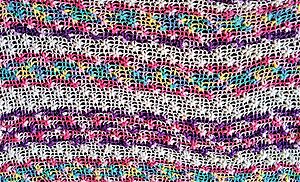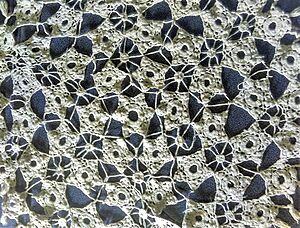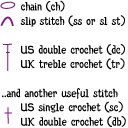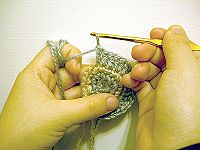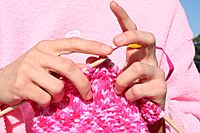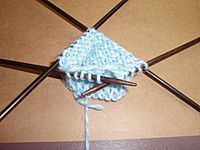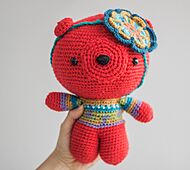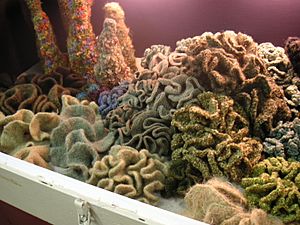Crochet facts for kids
Crochet is a fun way to create fabrics using a special tool called a crochet hook. You use the hook to pull loops of yarn or thread through each other, making a chain of stitches. The word "crochet" comes from a French word meaning "hook." Hooks come in many sizes and are made from materials like metal, wood, or bamboo.
Unlike knitting, where you keep many loops on needles at once, in most crochet, you finish one stitch before starting the next. However, some special types of crochet, like Tunisian crochet, do keep multiple stitches open at a time.
Contents
- What Does "Crochet" Mean?
- Where Did Crochet Come From?
- The Story of Irish Crochet
- Crochet Today: A Creative Journey
- How Crochet Helps Your Mind
- Crochet and Sustainable Fashion
- Tools and Materials for Crochet
- How to Crochet: The Basic Steps
- Learning Basic Crochet Stitches
- Understanding Crochet Terms
- Crochet vs. Knitting: What's the Difference?
- Crochet for Good: Craftivism
- Yarn Bombing: Art in Public Spaces
- Mathematics and Hyperbolic Crochet
- Styles in Crochet
- See also
What Does "Crochet" Mean?
The word "crochet" comes from the French word crochet, which means "little hook." It's related to an older German word, croc, also meaning "hook." In the 1600s, this term was used in French lace-making for a stitch that joined different lace pieces. Later, "crochet" became the name for both the craft and the hooked tool used to do it.
Where Did Crochet Come From?
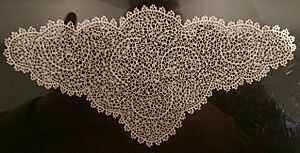
While we have examples of knitted fabrics from as far back as the 11th century, clear evidence of crochet fabric only appeared in Europe in the 1800s. Before that, some items that looked like crochet were actually made using a different technique called nålebinding.
There are a few ideas about where crochet truly began:
- Some think it started along Arab trade routes, spreading from Arabia to Tibet, then to Spain and other Mediterranean countries.
- Another idea is that it began in South America, where it was used for decorations in special tribal ceremonies.
- A third theory suggests crochet was used in China, where early dolls were made entirely with this technique.
The first time we saw written instructions for crochet, using the word as we understand it today, was in a Dutch magazine called Penélopé in 1823. It even showed pictures of crocheted purses made with silk thread. These instructions mentioned using a special tambour needle, which looked a lot like modern crochet hooks.
An English diary from the early 1800s, written by Elizabeth Grant, mentioned "shepherd's knitting," which was a way of looping yarn with a hook. This shows that similar techniques were being used around the same time.
By the 1840s, many books about crochet started appearing. One book from 1844 described crochet hooks, sometimes called "Shepherds' hooks," made from steel, ivory, or wood. It said they had a hook at one end, like a fish-hook, to catch and pull the yarn.
It seems that modern crochet might have grown from two main traditions: French tambour embroidery and shepherd's knitting. Tambour embroidery used a hook to create chain stitches, similar to how crochet works today. Shepherd's knitting used a hook for making fabric with yarn. Over time, these different methods likely combined to create the crochet we know today.
Early hooks were often tapered (getting thinner towards the end), which was good for some stitches. But as crochet developed, hooks with a more cylindrical (straight) shaft became common, especially for stitches that needed to hold many loops at once. Today's hooks often combine both tapered and cylindrical parts.
The Story of Irish Crochet
In the 1800s, during the Great Irish Famine in Ireland, crochet lace became a way for people to earn money. It was a form of relief to help families who were struggling. Many people, including men, women, and children, learned to crochet and made beautiful lace products.
Schools were set up to teach this craft, and teachers traveled across Ireland to share their skills. When Irish people moved to other countries, like the Americas, they took their crocheting skills with them. Mademoiselle Riego de la Branchardiere is often given credit for inventing Irish Crochet and published the first pattern book in 1846. Irish lace became very popular in Europe and America and was made in large amounts until World War I.
Crochet Today: A Creative Journey
Fashions in crochet changed a lot after the Victorian era ended in the 1890s. In the new Edwardian era, especially between 1910 and 1920, crocheted laces became even more detailed and complex.
The bright colors of the Victorian age faded, and new patterns often used white or light-colored threads. However, fancy purses were still made with bright silk and decorated with beads. After World War I, fewer crochet patterns were published, and they were often simpler.
After World War II, from the late 1940s to the early 1960s, there was a big comeback for home crafts, especially in the United States. Many new and creative crochet designs appeared for colorful doilies, potholders, and other home items. These patterns used thicker threads and yarns, often with many colors.
Crochet was mostly seen as a hobby for homemakers until the late 1960s and early 1970s. Then, a new generation discovered crochet and made "granny squares" very popular. These colorful, round motifs became a symbol of the era.
Even though crochet's popularity went down for a while, the early 2000s saw a big return of interest in handmade crafts and DIY projects. Yarns also became much better quality and came in more varieties. Besides books and classes, you can now find tons of helpful tutorials on YouTube and TikTok to learn how to crochet.
Today, crochet is used in educational programs to explore identity and self-expression, mixing art with technology. Many young people enjoy crocheting stuffed animals (called Amigurumi), hats, and even flowers.
There are many different styles of crochet, like Micro crochet, Filet crochet, Tunisian crochet, tapestry crochet, broomstick lace, hairpin lace, cro-hooking, and Irish crochet. Each one offers a unique way to create beautiful items.
How Crochet Helps Your Mind
Crocheting can be really good for your mental well-being. It can help people deal with stress, sadness, big life changes, and even manage ongoing pain or illness. Crochet is usually inexpensive, easy to carry around, and most people can learn the basic stitches quickly.
The hands-on and creative nature of crochet has been shown to make people feel happier and build a sense of community. A study in 2020 found that almost 90% of crocheters felt calmer, 82% felt happier, and nearly 75% felt more useful. These benefits come from how affordable, portable, and easy to learn crochet is.
Crochet and Sustainable Fashion
Crochet can be a big part of sustainable fashion. Many crocheters use recycled or eco-friendly materials like bamboo, hemp, cotton, linen, and wool. While synthetic fibers like acrylic and polyester are also common, there's a growing trend towards natural options.
Since most crochet is done by hand, it supports "slow fashion." This means making clothes and accessories carefully and thoughtfully, instead of the fast, mass-produced items from the "fast fashion" industry. There are crochet machines, but they don't produce items on the same huge scale as other textile machines.
Another great thing about crochet is that you can easily undo a crocheted item and reuse the yarn for something new. You can also add crochet to old or torn clothes, like a new collar or sleeves, to give them a fresh look and upcycle them. Crochet focuses on quality over quantity, making each item unique and personalized. It's also very versatile, so you can make many different products, reducing the need to buy new things all the time.
Many yarn brands are now focusing on sustainability. They are increasing their production of natural fibers like organic cotton, hemp, wool, and recycled yarns.
Crocheted items have become a popular way to create sustainable fashion. Even some fast fashion brands try to copy the look of crocheted items.
Crochet has also made a comeback on fashion runways. For example, Christopher Kane's Fall 2011 collection featured many granny squares. Websites like Etsy and Ravelry make it easy for people who love to crochet to sell their patterns or finished projects online.
Tools and Materials for Crochet
The main things you need for crocheting are a hook, scissors to cut your yarn, and some material to crochet with, usually yarn or thread. Some people even crochet with their hands for very thick yarns!
Yarn comes in different thicknesses, called "weights." The weight of the yarn affects how your finished project looks and feels. You can also use acrylic yarn, which is a synthetic alternative to wool.
Other helpful tools include:
- Cardboard cutouts for making tassels or fringe.
- A pom-pom maker for fluffy pom-poms.
- A tape measure and a gauge measure to check your work and count stitches.
- A row counter to keep track of rows.
- Plastic rings for special projects.
In recent years, the types of yarn available have expanded beyond synthetic, plant, and animal fibers to include materials like bamboo, qiviut (from muskox), hemp, and even banana stalks. Many experienced crocheters also use recycled materials like plastic bags, old T-shirts, or cassette tape to create unique textures and be more eco-friendly.
Crochet Hooks: Your Main Tool
Crochet hooks come in many sizes and materials. The size of the hook refers to the diameter of its shaft. You choose a hook size to make stitches that match the "gauge" (stitch size) mentioned in your pattern. If your stitches are too big or too small, you can switch to a different hook size.
Crafters often have favorite hook materials. Some prefer bamboo or wood hooks over metal because they feel warmer and more flexible, especially if they have hand conditions like arthritis. You can also find hooks with special grips or ergonomic handles for comfort.
Aluminum, bamboo, and plastic hooks are available in sizes from 2.25 to 30 millimeters. Steel crochet hooks are used for very fine work, like doilies and lace. These are sized differently: a higher number means a smaller hook.
For Tunisian crochet, you use longer hooks with a stopper at one end, because you hold many loops on the hook at once. There are also double-ended crochet hooks with a hook on both ends.
Yarn Types: What to Use
Yarn for crochet is usually sold in balls or skeins (hanks). Each ball or skein comes with a "yarn band" label. This label tells you important things like the yarn's thickness (weight), length, color batch (dye lot), what it's made of, washing instructions, and what hook size is suggested.
It's a good idea to save the yarn band. If you need more yarn for a project, try to buy skeins from the same "dye lot." This means they were dyed together and will have the exact same color. Yarns from different dye lots might look slightly different and could create a visible stripe in your work.
The thickness of the yarn is very important. Thicker yarns usually need larger hooks and make bigger stitches. This means you'll need fewer stitches and less time to finish a project. Thinner yarns are best for delicate and detailed patterns. Yarns are grouped into categories like superfine, fine, light, medium, bulky, and superbulky.
Before you start, if your yarn is in a hank, you might want to wind it into a ball. This makes it easier to pull the yarn from the center without it getting tangled.
Yarns are made from different fibers:
- Animal fibers: Like wool (from sheep), alpaca, llama, and silk. Wool is popular because it's stretchy and warm.
- Plant fibers: Like cotton, flax (for linen), bamboo, and hemp.
- Synthetic fibers: Like acrylic and polyester.
Sometimes, different fibers are mixed together in one yarn, like alpaca and silk. Each type of yarn has its own special qualities, so the "best" yarn depends on what you're making!
How to Crochet: The Basic Steps
To start crocheting, you usually make a slip knot on your hook. Then, you pull another loop through the first, and repeat this to make a chain of stitches. This chain is the foundation of your project.
You can work in rows, going back and forth, or in rounds, joining the chain to make a circle and working in spirals. Each stitch is made by pulling loops through the previous ones. In most crochet, you only have one loop on your hook at the end of each stitch. However, in Tunisian crochet, you collect all the loops for a whole row on your long hook before working them off.
Learning Basic Crochet Stitches
There are a few main types of basic stitches. Here's how they are generally described (with US terms in brackets):
- Chain stitch (ch): This is the most basic stitch and starts most projects. You wrap the yarn around the hook (yrh) and pull it through the loop on your hook.
- Slip stitch (sl st or ss): Used to join a chain into a ring or to move your hook across stitches without adding height. Insert hook into work, yrh, and pull through both loops.
- Single crochet (sc) (UK = Double crochet): Insert hook into work, yrh, pull up a loop (2 loops on hook), yrh, pull through both loops.
- Half double crochet (hdc) (UK = Half treble): Yrh, insert hook into work, yrh, pull up a loop (3 loops on hook), yrh, pull through all three loops.
- Double crochet (dc) (UK = Treble): Yrh, insert hook into work, yrh, pull up a loop (3 loops on hook), yrh, pull through 2 loops, yrh, pull through the last 2 loops.
- Treble (tr) (US = Triple or Triple crochet): Yrh twice, insert hook into work, yrh, pull up a loop (4 loops on hook), yrh, pull through 2 loops, yrh, pull through 2 loops, yrh, pull through the last 2 loops.
These stitches create different heights. For example, a double crochet stitch is taller than a single crochet stitch. More advanced stitches are often combinations of these basic ones or involve putting your hook in unusual places. Some examples include the shell stitch, V stitch, popcorn stitch, and crocodile stitch.
Understanding Crochet Terms
There are two main ways to describe crochet stitches: one used in Europe, Australia, and other countries, and another used in the US and Canada. This can sometimes be confusing when reading patterns!
To help, a system of diagrams with standard symbols is often used. In the United States, the Craft Yarn Council helps set standards for crochet terms, hook sizes, and yarn labels.
| International term | US term |
|---|---|
| Double crochet (dc) | Single crochet (sc) |
| Half treble (htr) | Half double crochet (hdc) |
| Treble (tr) | Double crochet (dc) |
| Double treble (dtr) | Triple crochet (tr) |
| Double crochet 2 together (dc2tog) | Single 2 together (sc2tog) |
| Treble 2 together (tr2tog) | Double 2 together (dc2tog) |
Another important term is "gauge" (US) or "tension" (international). This refers to how tightly or loosely you crochet. If your gauge is different from the pattern's, your finished item might be a different size. To fix this, you can make a small test piece (a "swatch") and adjust your hook size if needed.
Crochet vs. Knitting: What's the Difference?
One big difference is that crochet uses one hook, while most knitting uses two needles. In most crochet, you only have one active stitch on your hook at a time (except for Tunisian crochet). Knitters, however, keep a whole row of stitches on their needles at once.
If you drop a stitch in knitting, the fabric can unravel easily. In crochet, if a stitch breaks, the stitches around it usually stay in place because of how they are looped together.
Making round or tube-shaped items is easy with a regular crochet hook. For knitting, you need special circular needles or several double-pointed needles. Many crocheted items are made from individual pieces, called motifs, which are then joined together. Knitting usually creates one continuous piece of fabric.
Freeform crochet is a technique that lets you create interesting 3D shapes. You can add new stitches almost anywhere on your crocheted piece.
Knitting can be done by machines, but many crochet stitches can only be made by hand. Crochet stitches are generally taller than knitted stitches. For example, a single crochet stitch is about twice the height of a knit stitch made with the same yarn and hook/needle size.
Some people think crochet uses more yarn and creates a thicker fabric than knitting. While a single crochet stitch might use a bit more yarn than a basic knit stitch, you can change the feel and drape of crochet by using a larger hook or thinner yarn. Some crochet styles, like slip stitch crochet, can even use less yarn than knitting for similar projects.
Any yarn can be used for both knitting and crochet, but it's good to consider the yarn's qualities. For example, fluffy, thick wool yarns often work well for knitting, while thin, tightly spun yarn is great for the firm texture needed for Amigurumi crochet.
- Differences between crochet and knitting
-
For amigurumi, crocheting creates a knobbier and more structured texture compared with knitting.
Crochet for Good: Craftivism
It's been common for people to crochet clothes and other items to donate to soldiers during wars. People have also crocheted for hospitals, making items for sick patients and newborn babies. Sometimes groups crochet for specific charities, like homeless shelters or nursing homes.
It's also very popular to crochet hats (often called "chemo caps") and donate them to cancer treatment centers. These hats help people who are losing their hair due to chemotherapy. During October, pink hats and scarves are often made, and the money raised is donated to breast cancer funds. Organizations like Knots of Love, Crochet for Cancer, and Soldiers' Angels use crochet to help people in need.
In 2020, people worldwide crocheted kangaroo pouches, koala mittens, and wildlife nests to help animals affected by the Australian bushfires. This was a huge international effort to help during a very bad bushfire season.
A group that started in 2005 to crochet coral reefs grew to over 20,000 contributors by 2022. This "Crochet Coral Reef Project" aims to raise awareness about global warming. Their creations have been shown in galleries and museums to millions of people. Many of these crocheted reefs use hyperbolic (curved) geometric shapes to look like natural coral.
Yarn Bombing: Art in Public Spaces
In recent years, a fun practice called yarn bombing has become popular. This is when people use knitted or crocheted fabric to decorate public spaces, usually outdoors. Yarn bombers sometimes cover existing graffiti or add colorful touches to trees and sign poles.
In 2010, a mysterious "Midnight Knitter" decorated West Cape May with knit cozies on tree branches. In September 2015, Grace Brett was called "The World's Oldest Yarn Bomber." She is part of a group called the Souter Stormers, who beautify their town in Scotland with yarn art.
Mathematics and Hyperbolic Crochet
Crochet has been used to create models of shapes in "hyperbolic space." These shapes are hard to show in drawings or with other materials. Mathematician Daina Taimiņa first used crochet in 1997 to make strong models of hyperbolic space. These models help people understand how a line can look curved in hyperbolic space but actually be straight. Her work has been featured in exhibitions.
You can see hyperbolic structures in nature, like in lettuces, sea slugs, and coral. Margaret Wertheim and Christine Wertheim created a traveling art exhibit of a coral reef using Taimina's crochet method. Local artists are encouraged to make their own "satellite reefs" to add to the display. This type of crochet has become popular, with shows like Sant Ocean Hall at the Smithsonian and Sticks, Hooks, and the Mobius: Knit and Crochet Go Cerebral at Lafayette College.
Styles in Crochet
- Mosaic crochet
- Granny square
- Freeform crochet
- Motifs
- Crocheted lace
- Tunisian crochet
- Tapestry crochet
- Amigurumi
- Filet crochet
- Corner to Corner (C2C) Crochet
- Irish crochet lace
- Bead crochet
- Doily
See also
 In Spanish: Ganchillo para niños
In Spanish: Ganchillo para niños
- List of crochet stitches
- Crochet Guild of America
- The Tempestry Project
- Fiber art
- Macramé
- Tatting
- Knitting
- Sewing
- Embroidery


